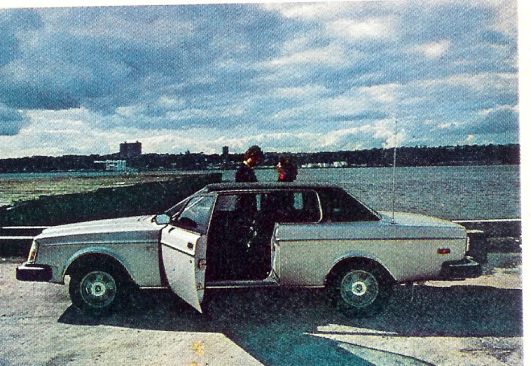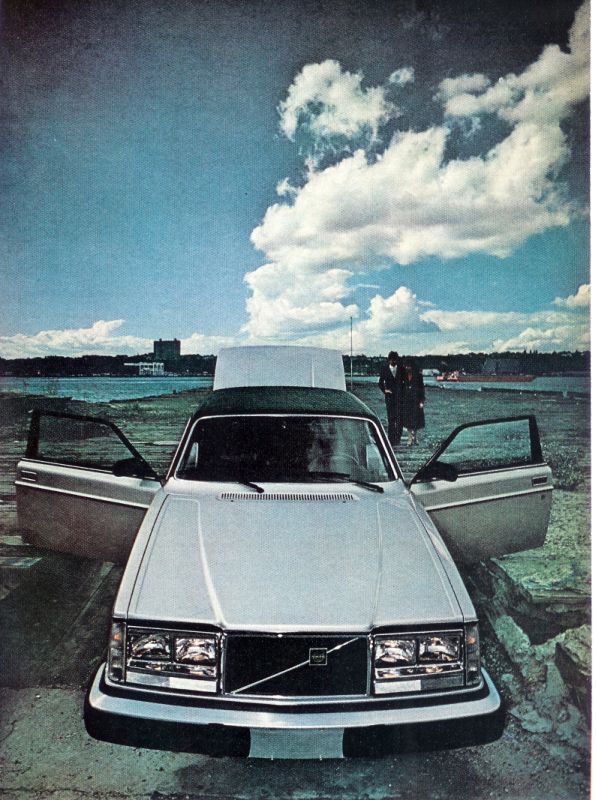Start with precise, Swedish-steel components, assemble them
inside a prestigious, luxury coach builder's shop, trim the
package with fine leather, add a generous assortment of con-
venience features, put the result on steel-belted radials, and
you wind up with Volvo's stunning new 262C coupé.
This elegant package is the result of a truly international
effort. Batches of parts are shipped from Sweden to the Ber-
tone carrozzeria in Torino, Italy. At Bertone's custom shops
each vehicle is carefully assembled in accordance with Volvo's
rigid engineering standards. Like the world's other great luxury
cars, each 262C receives the special attention that only indi-
|
literally covered with the stuff. Every interior surface except the
floor and dashboard is graced by hand-crafted, hand-stitched,
buttery-soft black leather The anatomically designed seats are
trimmed in soft pleats or creases and highlighted by leather
braiding, which imparts something of the look of fine living-
room furniture In addition to looking luxurious, the soft hides
feel (and smelt) absolutely delicious The lavish use of leather
on the steering wheel, door panels, headrests, and sun visors
heightens the sensuality of the environment Even the padded
headlining is covered in soft, black hide. The Volvo 262C will
unquestionably be admired for having one of the plushest
|
vidual hand labor can pro-
vide. The result is an ele-
gant, format coupé, in the
same class as the BMW CSi
and the Mercedes-Benz
450 SLC.
Bertone was selected to
produce the 262C for sev-
eral reasons. It is virtually
impossible to create such a
luxury vehicle on a conven-
tional assembly line, where
only a brief time interval is
available for each opera-
tion. The superb quality of
the paint and trim on the
test car indicates that many
more hours of hand labor
went into producing this car
than could have been prov-
ded on any assembly line.
|

|
interiors ever built into a
street car.
The 262C luxury pack-
age comes with a long list of
convenience items The in-
tegrated air-conditioning
system, with recirculating
capability, has the capacity
to dehumidify heated air
during the winter. For long
trips the cruise control on
the turn-indicator stalk pro-
vides added driver relax-
ation-and may even save
a little gas. A swiveling map
light above each door pro-
vides spot illumination
wherever needed. The
electrically operated win-
dows, radio antenna, and
outside rearview mirrors
|
Another reason for going to Bertone was that the limited
production planned for the 262C coupé created significant
logistical problems for an auto plant as big as Volvo's Only
1 1200 coupés will be produced in 1978, with 1.000 being
shipped to the United States and the rest distributed through-
out Europe. About 900 of the U.S. models will have three-speed
automatic transmissions, while the remainder wilt have four-
speed manual boxes with electric overdrive.
Though the pictures of the 262C shown here are excellent, it
is very difficult to capture the strong lines of this coupé on film
The car is sleek and assertive, with positive body and roof lines.
To achieve this look, nearly 2.5 inches were chopped from the
roof height of a standard Volvo. The resulting reduction in
side-window area produces a functional look usually as-
sociated with competition cars. Square headlights, nicely
blended into the grill, plus side mirrors with matte black protec-
tive shells further emphasize the car's muted yet unmistakable
elegance.
When you talk about upholstery in a luxury car, there is only
one material that wilt do-leather-and the in8ide of the 262C is
|
are controlled by push buttons at the driver's fingertips. And for
the ultimate in sybaritic motoring, the front seats are individually
heated to eliminate the shock of cold leather on those frosty
mornings.
The people who design Volvos must really love to drive, for
the cars they produce have a reputation for solid, reliable,
superior handling. With minor changes, the 262C's running
gear is the standard and ever reliable Volvo hardware. The front
suspension consists of a pair of spring struIs, incorporating
coils and telescopic shock absorbers. Body jean or roll is
limited by a stabilizer (or antisway bar) linking the front wheels
At the rear, an excellent live-axle arrangement delivers the
torque to the wheels and keeps the lires solidly on the road. For
anything other than an aIl-out competition car/ Volvo's setup is
probably the best possible arrangement in terms of durability,
low maintenance, and excellent ride control.
Fore and aft movement of the rear axle is controlled by two
trailing arms plus a pair of torque rods. Transverse motion is
limited by a hefty track rod, and a stabilizer bar minimizes body
roll. Coil springs and telescopic hydraulic shocks complete the
|
rear-suspension package, One point worth noting is that all elements are linked via rubber bushings,
which minimize vibration transfer and isolate road noises from the unitized body,
The beauty of this suspension system is that each element has a
single function and is designed specifically to handle only that function,
In addition to these basic Volvo engineering features, the 262C's
ride has been improved by the use of different tires, wheels, shocks, and springs,
The tires are low-profile Michelin 185/70-SR 14 steel-belted radials,
mounted on light-alloy rims, The other changes include slightly modified rear springs and
altered shock-absorber settings; the result is a marked improvement in the car's ability to
"smooth out" potholes, railroad crossings, and other rough surfaces at low speeds,
At higher speeds road-holding is definitely better than that of stock Volvo sedans,
with much of the credit going to the tires, These lowprofile radials provide a larger
contact area with the road, substantially increasing adhesion during high-speed cornering,
Power for the 262C is produced by Volvo's 2.7 liter, 162 cubic-inch overhead-cam V-6 engine,
This advanced design has a cast-aluminum block and head, wet-steel cylinder liners,
continuous-flow fuel injection, and solid-state transistorized ignition, Emission control is provided,
with minimal power loss by Volvo's lambda-sond three-way catalyst. Maximum output is 125 hp at 5,500 rpm and 148 ft Ibs,
of torque at 2,750 rpm, The most impressive characteristic of the engine is the jack of vibration at all speeds.
Jumping on the gas pedal produces smooth acceleration, without hesitation or vibration, from idle to red line,
Capable of cruising comfortably at speeds approaching twice the legal limit,
Volvo's 262C is one of that rare breed known in Europe as a Grand Touring car.
By definition, a GT car provides the utmost in automotive comfort,
luxury, and safety and is capable of maintaining extremely high speeds over all sorts of roads,
Even a brief drive will demonstrate how well the silver and black coupé fits the GT definition,
Oelivered for around $15,000, the 262C hardly qualifies as an economy package,
but it is the only true GT available today for under $20,000, Considering the quality of Volvo engineering,
the workmanship that goes with a Bertone nameplate, and the snob appeal of owning a limited production vehicle,
the 262C turns out to be a wiser and more realistic investment than a Cadillac Seville,
Financial considerations aside, driving a 262C is an investment in motoring pleasure
thaI will pay dividends to the discriminating driver for years to come.
Despite rising fuel casts and the dampening effect of emission-control regulation,
Volvo's GT coupé could well be the car that rekindles America's love affair with the automobile.
|


![]()